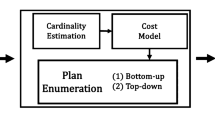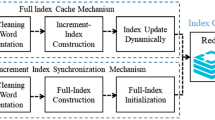Abstract
Detecting and dealing with redundancy is an ubiquitous problem in query optimization, which manifests itself in many areas of research such as materialized views, multi-query optimization, and query-containment algorithms. In this paper, we focus on the issue of intra-query redundancy, redundancy present within a query. We present a method to detect the maximal redundancy present between a main (outer) query block and a subquery block. We then use the method for query optimization, introducing query plans and a new operator that take full advantage of the redundancy discovered. Our approach can deal with redundancy in a wider spectrum of queries than existing techniques. We show experimental evidence that our approach works under certain conditions, and compares favorably to existing optimization techniques when applicable.
Similar content being viewed by others
References
Akinde M, Bohlen M (2003) Efficient computation of subqueries in complex olap. In: Proceedings of the ICDE Conference, pp 163–174
Chatziantoniou D, Ross KA (1996) Querying multiple features of groups in relational databases. In: Proceedings of the VLDB Conference, pp 295–306
Chatziantoniou D, Ross KA (1997) Groupwise processing of relational queries. In: Proceedings of the VLDB Conference, pp 476–485
Council TPP (n.d.) The tpc-h benchmark. http://www.tpc.org/tpch
Dayal U (1987) Of nests and trees: a unified approach to processing queries that contain nested subqueries, aggregates, and quantifiers. In: Proceedings of the VLDB Conference, pp 197–208
Galindo-Legaria CA, Joshi MM (2001) Orthogonal optimization of subqueries and aggregation. In: Proceedings of the SIGMOD Conference, pp 571–581
Ganski RA, Wong HKT (1987) Optimization of nested sql queries revisited. In: Proceedings of the SIGMOD Conference, pp 23–33
Goel P, Iyer B (1996) Sql query optimization: Reordering for a general class of queries. In: Proceedings of the SIGMOD Conference, pp 47–56
Goldstein J, Larson P-A (2001) Optimizing queries using materialized views: a practical, scalable solution. In: Proceedings of the SIGMOD Conference, pp 331–342
Gupta A, Harinarayan V, Quass D (1995) Aggregate-query processing in data warehousing environments. In: Proceedings of the VLDB Conference, pp 358–369
Halevy A (2001) Answering queries using views: a survey. VLDB J 10(4): 270–294
Hellerstein J (1998) Optimization techniques for queries with expensive methods. ACM Trans Database Syst 23(2): 113–157
Kim W (1982) On optimizing an sql-like nested query. ACM Trans Database Syst 7(3): 443–469
Kossmann D (2000) The state of the art in distributed query processing. ACM Comput Surv 32(4): 422–469
Li Z, Ng WK, Sun A (2005) Web data extraction based on structural similarity. Knowl Inf Syst 8(4): 438–461
Lu H, Chan HC, Wei KK (1993) A survey on usage of sql. ACM SIGMOD Record 22(4): 60–65
Millstein T, Halevy A, Friedman M (2003) Query containment for data integration systems. J Comp Syst Sci 66(1): 10–39
Muralikrishna M (1989) Optimization and dataflow algorithms for nested tree queries. In: Proceedings of the VLDB conference, pp 77–85
Muralikrishna M (1992) Improved unnesting algorithms for join aggregate sql queries. In: Proceedings of the VLDB conference, pp 91–102
Park J, Segev A (1988) Using common subexpressions to optimize multiple queries. In: Proceedings of the ICDE Conference, pp 311–319
Rao J, Ross KA (1998) Reusing invariants: a new strategy for correlated queries. In: Proceedings of the SIGMOD conference, pp 37–48
Roy P, Seshadri S, Sudarshan S, Bhobe S (2000) Efficient and extensible algorithms for multi query optimization. In: Proceedings of the SIGMOD conference, pp 249–260
Sellis TK (1988) Multiple-query optimization. ACM Trans Database Syst 13(1): 23–52
Seshadri P, Pirahesh H, Leung TYC (1996) Complex query decorrelation. In: Proceedings of the ICDE conference, pp 450–458
Ullman J (2000) Information integration using logical views. Theor Comp Sci 239(2): 189–210
Wan X (2008) Beyond topical similarity: a structural similarity measure for retrieving highly similar documents. Knowl Inf Syst 15(1): 55–73
Zaharioudakis M, Cochrane R, Lapis G, Pirahesh H, Urata M (2000) Answering complex sql queries using automatic summary tables. In: Proceedings of the SIGMOD conference, pp 105–116
Zhou J, Larson P-A, Freytag J-C, Lehner W (2007) Efficient explointation of similar subexpressions for query processing. In: Proceedings of the SIGMOD conference, pp 533–544
Zhu Q, Tao Y, Zuzarte C (2005) Optimizing complex queries based on similarities of subqueries. Knowl Inf Syst 8(3): 350–373
Zuzarte C, Pirahesh H, Ma W, Cheng Q, Liu L, Wong K (2003) Winmagic: Subquery elimination using window aggregation. In: Proceedings of the SIGMOD conference, pp 652–656
Author information
Authors and Affiliations
Corresponding author
Rights and permissions
About this article
Cite this article
Cao, B., Badia, A. Exploiting maximal redundancy to optimize SQL queries. Knowl Inf Syst 20, 187–220 (2009). https://doi.org/10.1007/s10115-008-0156-0
Received:
Revised:
Accepted:
Published:
Issue Date:
DOI: https://doi.org/10.1007/s10115-008-0156-0




